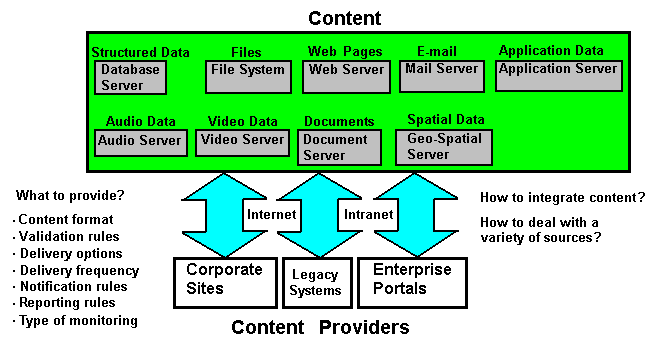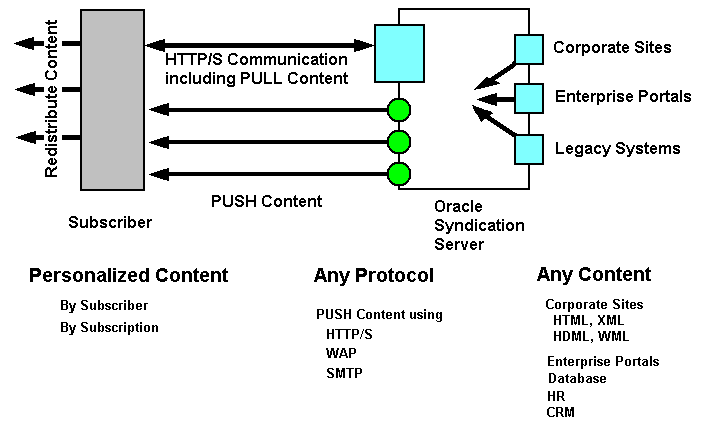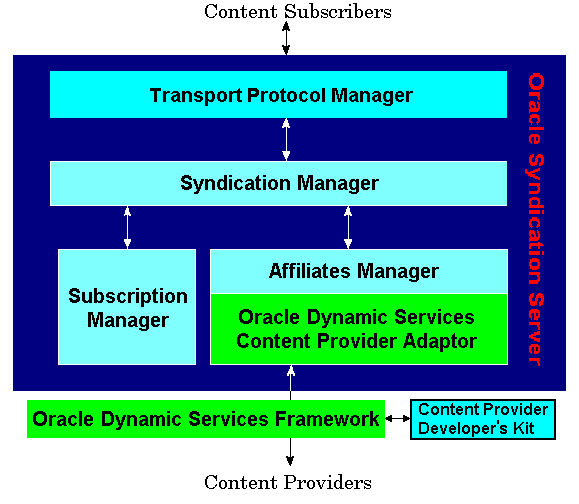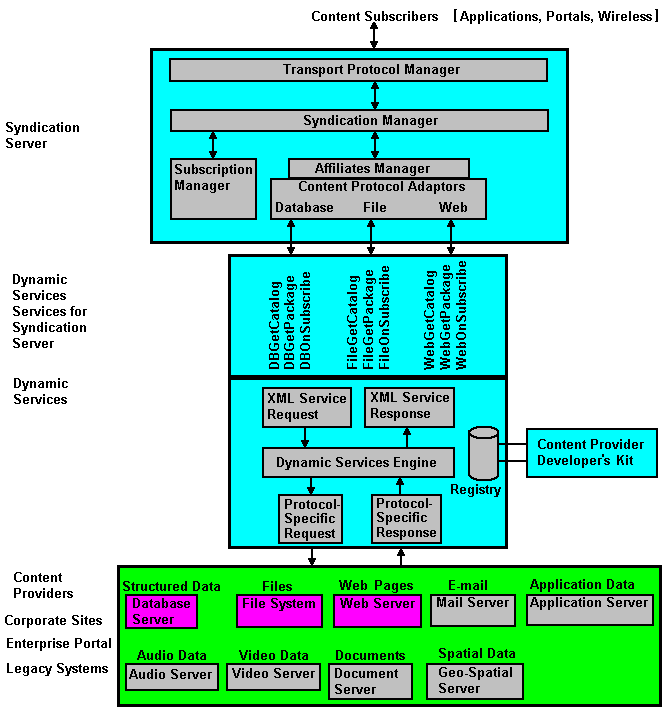Release 9.0.1
Part Number A88787-01
Home |
Book List |
Contents |
Index |
 Master Index |
 Feedback |
| Oracle Syndication Server User's and Administrator's Guide Release 9.0.1 Part Number A88787-01 |
|
As a feature of Oracle9i, Oracle Syndication Server is an extensible content syndication server designed to syndicate any Internet content to any Internet subscriber, using any Internet communication protocol in a secure way. It supports all available communication mechanisms including the Information and Content Exchange (ICE) Version 1.1 protocol. It allows access using a multitude of channels to Internet resources, enterprise portals, corporate databases, and conventional file systems. It features a comprehensive administration system to persistently maintain subscriptions for subscribers and profiles for content providers. It allows for the automated, controlled exchange, and management of online information among affiliated partners.
Content syndication is the aggregation, exchange, and distribution of information from content providers to syndicators to subscribers. The content providers provide the content, the syndicators send the content, and the subscribers, who subscribe to a set of subscriptions from a catalog, use the content.
With the advent of the Internet, syndication is rapidly evolving to:
A content subscriber acquires a content catalog of subscription offers from a content syndicator and selects the desired subscription offers. In the process of selecting each desired subscription, the content subscriber may negotiate business terms and delivery policies for each subscription with the content syndicator. When both sides come to an agreement, the subscription process is complete. As part of this agreement, a subscriber may wish to search for new information or have it automatically provided to them either when it is updated, or at some specified time interval.
Typically, sharing content (information) among affiliated groups of content providers through affiliate networks is an expensive, impromptu process. Each new partner requires customized, manual, time-consuming processes to update, share, and exchange content. As Figure 1-1 shows, the content syndicator struggles with each new affiliate member over content format, validation, delivery options and frequency, notification, reporting and monitoring, content integration into disparate Web servers, operating systems, databases, and other proprietary technology. Content comes from a variety of sources including dialup and ISDN connections, satellite dishes, FM broadcasts, SMTP e-mail servers, FTP servers, hard disks, and magnetic tapes.

With the emergence of the business-to-business (B2B) and business-to-consumer (B2C) markets, there is great demand for automating content exchange as well as business content online. The exchange is used for acquiring content for publishing and to fulfill business process requirements. Content syndication is the automated exchange of this content.
The Information and Content Exchange (ICE) standard (Version 1.1) manages and automates the establishment of syndication relationships, content transfer, and results analysis. The purpose of ICE is to replace these impromptu efforts of content exchange with a standardized, low-cost mechanism for managed, automated content exchange and content sharing of Web site assets between partners. Through the adoption of an industry-specific vocabulary, ICE provides a complete solution for syndicating any type of information between content syndicators and content subscribers. Content subscribers include networked partners and their affiliates.
As ICE becomes universally accepted and implemented across the Web, it will enable companies and industries of all sizes to take advantage of the vast amount of content on the Web, and establish business-to-business value chains in a low-cost, automated way. Web application developers can use ICE as a standard platform to exchange multiple data types, rapidly deploy applications, while protecting data privacy and incorporating existing standards. ICE dramatically reduces the cost and difficulty of creating and operating online distribution networks, and building value chains between suppliers, partners, distributors, and customers. ICE increases the value of business alliances by facilitating the controlled exchange and management of content among networked affiliates. Businesses can form partnerships with multiple affiliates at minimal incremental cost.
ICE defines a complete server-to-server syndication protocol and processing model. Within ICE, an XML-based common language and architecture is used to describe catalogs of content packages as subscriptions, as well as to schedule content delivery (push and pull), update type (incremental versus full), business rules, intellectual property rights, and all other aspects of automated content exchange.
Oracle Syndication Server is designed to deliver any Internet content to any Internet subscriber, and to automatically provide any content updates using any standards across any network. This radically simplifies the process of syndication or automated content exchange. Oracle Syndication Server provides a comprehensive solution for content aggregation, syndication, and distribution by letting you make available any or all of your content, to anywhere, at anytime, and deliver it securely. Content syndicators can use Oracle Syndication Server with the following benefits:
Figure 1-2 shows the key features of Oracle Syndication Server.

Oracle Syndication Server uses an ICE agent layered on Dynamic Services to take a content syndication or a content subscription request in the form of an XML document, which is validated against a predetermined ICE protocol Document Type Definition (DTD). A separate service request for each subscriber or syndicator is stored by using Oracle Dynamic Services. Each service request includes:
The ICE agent uses the underlying Dynamic Services engine to handle authorization, license management, transaction control, and billing management. The syndicator/subscriber relationship begins with establishing a subscription. The subscriber subscribes to particular syndicator subscription offers with mutually agreeable delivery methods and schedules. In one ICE communication channel, the syndicator distributes content to the subscriber. Each business entity could be either the syndicator or the subscriber, and both can issue an ICE request. Every logical ICE operation requires the request to be followed by the response.
ICE uses XML document exchange as its fundamental protocol model. ICE messages are valid XML documents, with a single ICE-payload root element and a structured hierarchy of tags describing the ICE operations and data.
ICE is bound to HTTP and uses a sequenced package model. The two basic ICE actions are push and pull. To send an ICE/HTTP payload, the sender performs an HTTP POST to a URL provided by the receiver. A payload is a single instance of an XML document formatted according to the protocol definitions contained in the ICE specification. ICE requests are specified using an ICE-request XML element, and ICE responses are specified using an ICE-response element. For ICE/HTTP, the ICE-request must be sent in an HTTP POST, and the ICE-response to that request must be sent in the HTTP response to that POST. Therefore, a single ICE request/response pair always maps directly to a single HTTP POST/corresponding response pair. Event logs are exchanged automatically for helping exception handling or problem diagnostics.
Oracle Syndication Server consists of the following components:
Table 1-1 describes each of these components.
Figure 1-3 shows the Oracle Syndication Server architecture.
Oracle Syndication Server uses the Oracle Dynamic Services framework that uses XML and Java. Syndication Server communicates using a Java servlet, which is deployed in a servlet container with any industry-standard Web listener, to receive and send messages, to adapt any content or information from Web sites, Internet applications, or a database into an XML representation. Syndication Server uses the Java servlet to transform that XML representation into a markup language specific to the subscriber through the use of XSL stylesheets. Each of these content source types (file, database, or Web) is modeled as a minimal set of services in the Oracle Dynamic Services framework.
All information about subscribers, their subscriptions, and content resources are stored in the Syndication Server registry residing in an Oracle9i database schema.

Section 1.4.1 through Section 1.4.3 describe the roles of content subscribers, the Oracle Dynamic Services framework, and the content provider developer's kit in syndicating information.
In the business of content syndication, a content subscriber is one of the two parties who obtains and repackages information and content from a content syndicator.
A Java-based programmatic framework for incorporating, managing, and deploying Internet and Intranet services. Application developers can rapidly, and more easily incorporate valuable services from Web sites, local databases, and proprietary systems into their applications using the Oracle Dynamic Services framework.
Oracle Dynamic Services content providers provide the content. Syndication Server provides three types of sample content providers: file, database, and Web. For each type of content provider, there is an instance of an Oracle Dynamic Services content provider adaptor. Each type of content provider must have the following minimum set of Oracle Dynamic Service (DS) services:
The Catalog DS service is used for content providers to provide catalog information of their available subscription offers. This service is used to enforce the uniformed input and output formats for all individually developed catalog DS services. However, each content provider defines its own semantics of a subscription offer.
The Subscribe DS service is used as a way for certain content providers to approve subscriptions before storing them in Syndication Server. The Subscribe DS service takes in a subscription request, which is forwarded by Syndication Server as input and returned as an approved subscription if the content provider agrees to all the terms. Upon disagreement, an exception is issued so that Syndication Server can start a negotiation process with the subscriber.
The Content Access DS service takes the unique subscription ID as input in order to collect all the related information and constructs a response payload according to the given DS service interface. Subscribers can initiate the process of pulling content from Syndication Server or have content pushed to them. Either path of content access executes a Content Access DS service.
The Dynamic Services content provider adaptor is also an extensible layer, so you can add additional types of content provider adaptors to support additional types of content providers.
Figure 1-4 shows the combined architecture of Oracle Syndication Server with Oracle Dynamic Services, and how the content provider adaptors relate to specific Oracle Dynamic Services services designed for Syndication Server.

Section 1.5.1through Section 1.5.5 describe and explain how the major operations of Oracle Syndication Server work beginning with processing a request from a subscriber who wants to access a specific content resource through Syndication Server. The operations involve:
Before a subscriber can access Syndication Server, an account must be created on Syndication Server for that subscriber. After the subscriber has reviewed all contractual, monetary, and business implications of the relationship with the Syndication Server, the Syndication Server administrator creates a user account for the subscriber and sends back a confirmation message. This confirmation message contains information about the subscribers account, such as his subscriber ID, subscription expiration date, the business terms of the subscription agreement, the delivery policy for delivering content, the location of the catalog of subscription offers, and how to obtain that catalog.
With his new subscriber account ID, the subscriber may make a get-catalog request to view all the catalog offerings. Syndication Server contacts all content catalogs from all the content providers that this subscriber has been given access to based on its profile information. After receiving all responses from the content providers, Syndication Server constructs a single catalog response and returns it to the subscriber. Each content catalog from a content provider is considered a single offer group in the generated catalog response, which is marked by that content provider's unique ID. Using the Oracle Dynamic Services service execution model, Syndication Server can aggregate content catalogs from a variety of content providers.
The subscriber reviews the catalog and chooses one content offer. He then supplies additional information as to his preference for negotiable parameters such as delivery policies, and business terms and then makes a request to get approval for a subscription. Syndication Server invokes the subscription manager to process the request, and possibly involves the corresponding content provider as needed. Following a possible negotiation process with the content provider, a subscription agreement is made, and having agreed to a set of terms, the subscriber receives a message indicating that the subscription is set and active.
If the subscription is enabled for pulling content delivery, the subscriber initiates a content access request and provides his subscription ID. Syndication Server pulls content from the corresponding content provider and returns it to the subscriber.
If the subscription is enabled for automatically pushing content to the subscriber, then the subscriber has two choices:
Syndication Server runtime operations are described in Section 1.5.5.1, Section 1.5.5.2, and Section 1.5.5.3.
Based on the type of request (Catalog, Subscribe, or Content Access) that is made by the content subscriber, the affiliates manager invokes the specified Dynamic Services content provider adaptor, which dynamically transforms the subscriber's request into an Oracle Dynamic Services service request that is then issued to the specified Dynamic Services engine.
At runtime, the Syndication Server invokes the specified Dynamic Services content provider adaptor. The adaptor dynamically transforms the subscriber's request into an Oracle Dynamic Services service request issued to the Dynamic Services engine, then collects the response of the service execution in a well-defined XML format, and returns it to the subscriber.
At runtime, the transport protocol manager selects a delivery Dynamic Services service corresponding to a specified protocol and executes it through the underlying Dynamic Services framework.
The transport protocol manager does the automatic packaging of content. This is an extensible layer for non-ICE protocols.
|
 Copyright © 1996-2001, Oracle Corporation. All Rights Reserved. |
|